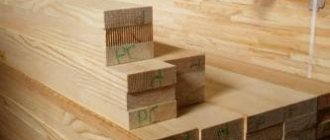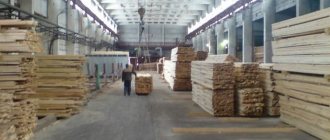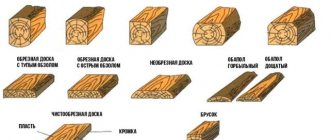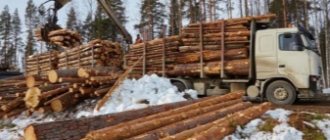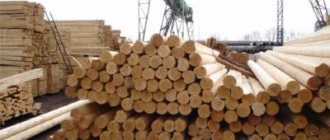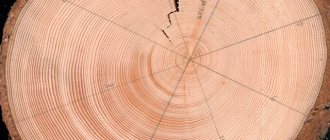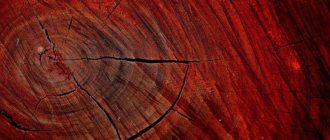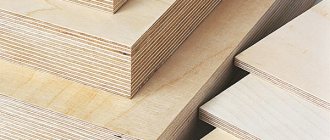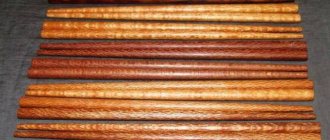Types of round timber
There are many different classifications of round timber. It’s worth starting with the classification by size:
- small ones have a thickness from 6 to 13 cm
- the average ones have a thickness from 14 to 24 cm,
- large in thickness from 26 cm or more.
Round-shaped timber is created from the butt, middle and apical parts of the trunk. Their length is more than 4 meters. Thick and short timber (about 2-2.5 m), most often from deciduous varieties. This material is used to create plywood, matches, containers, and sleepers.
According to their purpose, type of processing and production, all round timber is divided into the following groups:
- for sawing
- for planing and peeling
- for the production of cellulose and wood pulp
- for use in round form.
From timber that is intended for sawing and planing they create:
- aircraft lumber, deck and boat lining
- barrels and boxes
- lumber for the needs of mechanical engineering, construction and furniture industries
- sleepers and transfer beams for broad and narrow gauge railways
- blanks for skis, spools, shuttles, oars
- shoe lasts
- parts of horse-drawn cart wheels.
A log is a round assortment that is used in round form or as raw material for the creation of lumber.
A ridge is a round assortment from which special types of forest products are created. Their length corresponds to a multiple of the number of churaks.
Churaks are sections of ridge. They have a length that allows them to be processed on woodworking machines.
Depending on the purpose, timber can range from 0.5 (for barrels and boxes) to 14 m and even more (for creating barges).
An indicator of the quality of raw materials is its grade. It must satisfy certain consumer requirements. According to the quality characteristics, four varieties are distinguished among round timber:
- 1st grade. This group includes large-sized wood of the butt part. Butt logs that do not have knots, or have the smallest number of them, are used to create lumber for special purposes: in aviation, shipbuilding, and also for export
- 2nd grade. Such raw materials are obtained from the butt or middle part of the trunk. They are used to create lumber, which is then used in the construction industry, for the construction of barges, as well as in mechanical engineering. Some of these timber products are used in unprocessed form.
- 3rd grade. Materials of this type are obtained from any part of the trunk. They create lumber for mechanical engineering, construction, and the furniture industry. They are made into transfer bars for broad and narrow gauge railways. Such raw materials do not take into account the number of healthy knots
- Grade 4 is applicable in the engineering industry, construction, and the creation of furniture and packaging.
- Note that none of the listed varieties allows the presence of external rotten rot, the simultaneous presence of sapwood and heart rot in coniferous and sapwood deciduous species (birch or maple), or heart rot.
Construction logs are timber products that are used in round form. They are raw materials for the construction industry. Most often, coniferous logs are used for these purposes. Auxiliary and temporary buildings are created from deciduous varieties. Coniferous timber has a length of over 3 m, and deciduous timber from 4 to 6.5 m.
Wood defects: their types and impact on the quality of the material. Detailed classification according to GOST
Fiber inclination (oblique)
The inclination of the fibers, or informal. cross-grain is a common wood defect, which is characterized by a deviation in the direction of the fibers from the longitudinal axis of the trunk. There are two types of inclination of fibers in wood - tangential and radial.
- Tangential (natural) cross-layer is characterized by a helical arrangement of fibers. Found on the side surface of round timber.
- Radial (artificial) cross-cut occurs as a result of sawing crooked logs. It appears on the surfaces of boards and timber in the form of curved fibers located at an angle to the edge of the assortment.
Fiber inclination (cross-layer): tangential (natural) in a pine log, radial (artificial) in a board and natural
The inclination of the fibers reduces the strength of lumber, increases shrinkage in the longitudinal direction, and causes helical warping of the boards.
Curlyness
Curling, or simply curling, is the tortuous or chaotic arrangement of wood fibers. This feature is more common in larch trees and comes in two types:
- Wavy curling - the fibers are ordered relative to each other and have a wavy shape.
- Tangled curling - the fibers are located chaotically, there are characteristic “wormholes” on the cut; found mainly in burl wood.
Wavy curling in ash (left) and tangled curling in birch (right)
Curly wood is difficult to process, but it is highly valued because of its beautiful and unusual texture. Local curvatures of growth rings, which are often confused with ridges, are called whorls. Despite their external similarity, they belong to a separate group of defects.
Kren
A defect in the form of imaginary thickening and darkening of late wood (dark growth rings). Found in curved parts of trees (branches and trunks) facing the ground. The defect is more typical for coniferous species, especially spruce and fir; also common in trees growing on slopes.
There are two types of heel:
- local - it arises due to short bends of the trunk and appears in the form of narrow, non-continuous arched areas with darkening;
- solid - occurs at the ends of trunks that have been subjected to prolonged bending.
Roll: local (1) and continuous (2)
On longitudinal sections of lumber and in veneer, heel appears in the form of dark stripes. The heel area is characterized by increased hardness and gives the wood strength in compression and static bending. At the same time, such a defect reduces tensile strength, sharply increases shrinkage along the fibers, and promotes cracking and longitudinal warping of boards and timber. Also, the heeling zone significantly reduces the water absorption of wood, which makes it difficult to finish it with impregnating compounds.
False core
The inner zone of wood is dark in color and resembles heartwood in appearance but is not functionally heartwood. It is found in larch trees, more often in birch, hornbeam, linden, beech, alder or aspen. Such a pseudo-core is characterized by a discrepancy between its border and the growth rings, as well as the presence of a dark border at the border with light wood. The shape of the false kernel is round, lobed and star-shaped.
Internal sapwood
Visually, it is a rather interesting defect, manifesting itself in the form of a light annular layer inside a dark core. It is found in deciduous trees, most often such as oak or ash. A similar anomaly occurs due to disruptions in the functioning of the cambium during periods of severe frost. Despite the rather interesting effect on the end cut, the internal sapwood violates the strength of the heartwood and is less moisture resistant.
1. Internal sapwood; 2. False rounded nucleus; 3. False lobed nucleus
Dry-sidedness
Dry side, or dry side, is a local necrosis on the outside of the trunk, formed in places of mechanical damage to the bark and cambium layer on a growing tree. It looks like a recessed area, extended along the length of the trunk on one side. Along the edges of the dry road there are characteristic swells. Occurs due to abrasions, mechanical shocks, and damage to the trunk after fires. Found on all types of trees. In coniferous species, the wood adjacent to the dry shoulder is, as a rule, richly impregnated with resin. The wood in the dry shoulder area often has mushroom colors and is also eaten away by insects (horntails).
This defect changes the correct shape of round timber, causes local deformation of growth rings and violates the integrity of the wood in areas of overlap. All this negatively affects the physical and mechanical properties of wood and reduces the yield of lumber and veneer during industrial processing.
Sprouting
A sprout is an overgrown or healing wound on the surface of the trunk that contains bark and dead wood. There are two types of overgrowth: open (partially overgrown wound) and closed (completely overgrown wound). Sprouting violates the integrity of the wood and causes local deformation of growth rings, which negatively affects the physical and mechanical properties of the final lumber.
Germination: open (left) and closed (right)
Grinding
Resin - areas of coniferous wood that are heavily impregnated with resin. Visually they differ from the rest of the wood in a deeper dark color. They are formed as a result of mechanical damage to the tree trunk. Most typical of pine. It is detected on logs by the presence of wounds and accumulation of resin.
Tarred areas have less permeability and do not absorb moisture as actively; They also have higher density and resistance to biological damage. At the same time, tars are less easily processed by cutting tools and cause many problems during the finishing process.
Resin pockets
Defects of coniferous wood, which are cavities containing resins or gums. In a growing tree, pockets appear due to subcortical damage to the cambium or as a result of heating the trunk by sunlight during the cold season. The resin present in such cavities makes it difficult to saw the logs, as well as subsequent processing, finishing and gluing of wood.
In small parts, pockets reduce the strength of the wood, while in large structural elements their negative effect on strength is negligible.
Resin on the end and face of the board (left) and a resin pocket on the end of the log (right)
Round softwood timber
This category includes all round timber of coniferous varieties, which can be used in various fields of industry and the construction industry. The requirements for these materials are regulated by GOST 9463. According to the intended purpose, the length of softwood round timber can range from 1 meter (of which containers are made) to 17 m, from which masts for ships and radios are made. There are 4 grades based on quality: 1, 2, 3 and 4. It is worth considering that logging of small timber can be carried out only from grades 2 and 3, and for medium and large timber - from all grades.
Separation by grade is carried out according to the intended purpose of the timber. For example, 1st grade timber is used to create high-quality and special materials (aviation, resonance, deck), as well as in cases where high-quality wood is needed, without knots or with a small number of them. Second grade timber is used for the construction and engineering industries, as well as in shipbuilding. This raw material is also used to produce peeled veneer and cellulose.
Grade 3 timber that has rot is sent for sawing, and if there is no rot, it is used in round form in construction, to create communication lines, for example, poles, piles, communication and power transmission towers. Grade 4 timber is used to create various containers, small-section lumber and raw materials for chemical processing.
Preface
The goals, basic principles and procedure for carrying out work on interstate standardization are established by GOST 1.0-2015 “Interstate standardization system. Basic provisions" and GOST 1.2-2015 "Interstate standardization system. Interstate standards, rules and recommendations for interstate standardization. Rules for development, acceptance, updating and cancellation"
Standard information
1 DEVELOPED by the Federal State Unitary Enterprise "State Scientific Center of the Timber Industry Complex" (FSUE "SSC LPK")
2 INTRODUCED by the Interstate Technical Committee for Standardization MTK 78 “Timber”
3 ADOPTED by the Interstate Council for Standardization, Metrology and Certification (protocol dated July 27, 2016 No. 89-P)
The following voted for adoption:
| Country name according to MK (ISO 3166) 004—97 | Country code according to MK (ISO 3166) 004—97 | Abbreviated name of the national standardization body |
| Armenia | A.M. | Ministry of Economy of the Republic of Armenia |
| Belarus | BY | State Standard of the Republic of Belarus |
| Kyrgyzstan | KG | Kyrgyzstandard |
| Russia | RU | Rosstaidart |
4 By Order of the Federal Agency for Technical Regulation and Metrology dated September 30, 2016 No. 1255-st, the interstate standard GOST 9463-2016 was put into effect as a national standard of the Russian Federation from May 1, 2022.
5 This standard takes into account the main regulatory provisions of the following European standards:
— EN 1927-1:2008 “Quality classification of round timber. Part 1. Spruce and fir" (“Qualitative classification of softwood round timber - Part 1: Spruces and firs”, NEQ);
— EN 1927-2:2008 “Quality classification of round timber. Part 2. Pine" (“Qualitative classification of softwood round timber - Part 2: Pines”. NEQ);
— EN 1927-3:2008 “Classification of the quality of round timber. Part 3. Larch and Douglas fir (“Qualitative classification of softwood round timber - Part 3: Larches and Douglas fir”, NEQ)
6 INSTEAD GOST 9463-88
Information about changes to this standard is published in the annual information index “National Standards”, and the text of changes and amendments is published in the monthly information index “National Standards”. In case of revision (replacement) or cancellation of this standard, the corresponding notice will be published in the monthly information index “National Standards”. Relevant information, notices and texts are also posted in the public information system—on the official website of the Federal Agency for Technical Regulation and Metrology on the Internet (www.gost.ru)
©Standardinform, 2016
In the Russian Federation, this standard cannot be fully or partially reproduced, replicated and distributed as an official publication without permission from the Federal Agency for Technical Regulation
GOST 9463-2016
Content
1 Scope……………………………………………1
2 Normative references……………………………………………………………1
3 Dimensions and classification…………………………………………2
4 Technical requirements…………………………………………………….3
5 Safety requirements……………………………………………………5
6 Rules for acceptance and control…………………………………….5
7 Transportation and storage……………………………………..5
III
INTERSTATE STANDARD
ROUND CONIFEROUS TIMBER Technical specifications
Round timber of coniferous species. Specifications
Date of introduction—2017—05—01
Round hardwood timber
Most often, deciduous round timber is harvested from trees such as oak, beech, hornbeam, birch, linden, ash, alder, maple and chestnut. From these raw materials, carpentry, various equipment and auxiliary building structures are created.
Oak wood is highly durable; it does not rot, either in air or in water. Round oak timber is used to create lumber, which is used in the production of parquet, doors, window frames, various parts, furniture, and barrels.
Also, various structures are made from oak during the construction of underground and underwater buildings.
Well frames and piles are made from alder. Beech, birch, alder, linden, poplar and aspen are used in the construction industry to create open racks, struts, crossbars, and purlins that are accessible for inspection and ventilation.
Like coniferous timber, deciduous timber is divided into 4 grades, according to quality and purpose.
